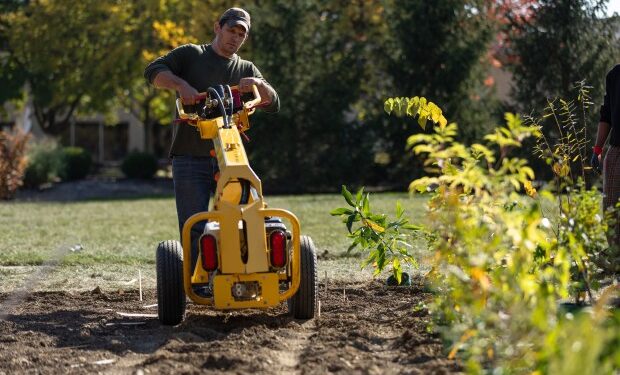Illinois has some 4.8 million acres of forest land. Just minutes southwest of Peoria, you’ll find Sand Ridge, a sweeping expanse of oak-hickory forest and pines. Out towards Rockford, there’s Lowden Miller State Forest, nestled in Rock River Valley.
Or, if you’re not up for a drive, you can find woodlands at an unlikely urban home — Naperville Central High School.
It’s not the wide swath of forest land you’d find in Sand Ridge or Lowden, but it certainly packs a biodiverse punch.
Last week, the school welcomed a “tiny forest” to its grounds. Smaller than a tennis court, the plot is just like it sounds: a small-scale, densely packed garden of trees occupying a corner of Central’s front lawn.
The miniature thicket is the brainchild of senior Sabrina Tse, who devised and designed the school-appropriate forest as part of a capstone course. In the works for the better part of a year, Tse spent this past weekend bringing the idea to life with the help of classmates and teachers.
Together, they planted some 276 trees on just under 1,100 square feet of the campus. Just saplings to start, it will be a while before the forest is fully matured. But the hope, Tse says, is to eventually have the hub of greenery grow to be a self-sufficient ecosystem like any other forest you’d find across the state — just a lot smaller.

Still, “a tiny forest is not a tiny job,” nor does it have a tiny impact, Tse quipped in an interview.
The concept is rooted in a method for quickly restoring natural and native forests developed in the 1970s by Japanese botanist Akira Miyawaki, according to UNESCO, the United Nation’s cultural agency.
The essential principle of the Miyawaki method is recreating the natural structure of a forest in scaled-down form, says the environmental nonprofit Earthwatch Europe.
How it works is after extensive soil preparation, a wide variety of native plant seedlings are planted in dense clumps, much closer together than you’d find in a traditional forest, per a 2019 report from JSTOR Daily, a magazine produced by the nonprofit digital research archive JSTOR.
The idea is that early on, plantings compete with each other for space and access to light and water, resulting in much faster growth. With the Miyawaki method, trees can grow about 10 times faster than with typical afforestation, which is the process of planting trees in an area where there hasn’t been recent tree cover.

Tse came across tiny forests last year in a course taught by Central social studies teacher Seth Brady. As part of the course, Tse was tasked with identifying and ultimately tackling a question tied to a global issue.
Tse found herself faced with a question that asked: What is the best way to address and combat biodiversity loss in urban and suburban areas? The query sent Tse on a long few weeks of researching until she stumbled upon a 2023 New York Times article with a headline that read, “Tiny Forests with Big Benefits.”
“I just thought it was so interesting,” Tse said. And apt for her course work.
“The fact that it can be placed in a variety of different locations is really compelling because biodiversity loss usually has to be combated very locally. It’s not a one-size-fits-all solution,” Tse said. But the prospect of a tiny forest offered Tse the unique opportunity to apply practiced methods to a Naperville-centric solution.
Today, tiny forests can be found in Europe, Africa, Asia, South America, Russia and the Middle East, the New York Times reported. More recently, they’ve been cropping up in the United States. In 2022, Illinois embraced its first tiny forest outside the Cook County courthouse in Markham.
Naperville Central’s is the second.
Though inspired through Tse’s individual project, the 18-year-old is quick to say that bringing her local tiny forest aspirations to fruition was “just an incredible team effort.”
For instance, materials for the forest — think anything from compost and mulch to manure — were made possible by grant funding through Naperville’s local freemasons, the Society for Biodiversity Preservation and the Clifford Crone Foundation. Tse also secured in-kind donations from Lowe’s and Groot Industries.
Trees were purchased from Possibility Place Nursery in Monee.
Naperville Central’s tiny forest is composed of 37 different species of native trees. They’re planted in an intricately-planned plot arranged by height, designed so that once fully grown, its canopy has inherent layers, Tse said.
Now that it’s planted, the next step will be maintenance, monitoring and data collection. For the forest’s first few years, it will need to be watered and weeded, Tse said. Beyond that, it also will have to be regularly tested on a score of data points to see how its faring — and how it’s impacted the environment around it.
“We want to keep track of all the scientific aspects to it so we’ll put in temperature sensors to see how it impacts temperature,” Tse said. “We’ll check soil stability, soil quality, the height of the trees.”
With Tse less than a year out from graduating and heading off to college, most of that work will fall to future Naperville Central students, she said. But she plans to visit whenever she’s in town.
“You can’t get rid of me,” she said.

Tse is excited to see what results and lessons the forest will supply as it ages, she said. Beyond that, she’s even more excited to see if it inspires other localized solutions to building a more sustainable urban environment.
“This won’t fix the world,” she said, “but it’s going to help this community. And if the next community learns about it, then maybe they’ll do a little bit better. And as you scale it, local change ends up being really important because if no one did local change, you’d never have global change.
“I don’t think anyone at (Naperville Central) knew what a tiny forest was a year and a half ago. And now I think everyone who knows me, knows about my capstone.”
Not so tiny, after all.







